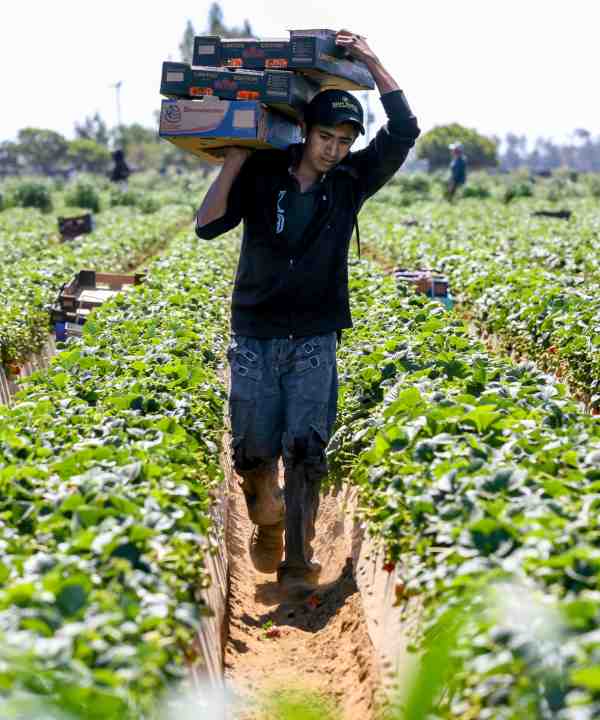October 08, 2020 | Water in the West | News
Feeding the U.S. comes at a high cost to the environment and people of Mexico, according to new Stanford-led research. The study, recently published in Environmental Science & Policy, examines the economic, environmental and social sustainability of agriculture reliant on desalination in San Quintín, Mexico – one of the country’s most productive farming regions. They identify policy interventions to regulate desalination and protect water resources while also addressing inequities experienced by people living in the region.
"Today, as a society, we are facing staggering social and environmental challenges caused by some of the infrastructure and technological decisions made in the past century. To avoid further exacerbating these challenges or creating new ones, we have to do a better job accounting for possible social and environmental impacts of the decisions we are making today and technologies we are deploying,” said co-author Newsha Ajami, director of the urban water policy program at Stanford’s Water in the West program.
Desalination for food production is increasing in arid areas across the globe as growing populations and climate-induced droughts place more stress on water sources and agricultural production. One such region, the San Quintín valley on the northern Baja California coast, relies on desalination of brackish local groundwater to grow water-intensive crops such as strawberries, cucumbers, onions and tomatoes for export to the U.S.
Multiple small-scale desalination plants owned by private agricultural businesses have sprouted across the region, but growing produce for export comes at a high cost to the area’s dwindling groundwater resources. As the valley continues its transition to desalination, the region and its people face a complex set of challenges. While some desalination studies have identified environmental or economic impacts, there is limited understanding of how it influences social sustainability.
“We wanted to know, were the benefits accrued due to adoption of a specific technology or policy distributed equitably?” said study lead Gemma Smith, a PhD student at Stanford's Emmett Interdisciplinary Program in Environment and Resources. “Would population growth and migration change when a new water source is available? Were local plans and policies equipped to handle these impacts?”
The team collected and analyzed data from the water, energy and food sectors including well permits, census data, agricultural production and pricing, desalination project records and environmental impact assessments. They also surveyed 30 of the 54 operating desalination plants in the region. Using this information, the researchers examined the environmental, economic and social costs and benefits of producing desalinated water to irrigate export crops.
They found that while groundwater over-exploitation, mostly due to agriculture, began prior to the introduction of desalination plants, currently 78 percent of water pumped from groundwater basins is used for crop irrigation, intensifying the rate at which local water resources are being depleted. This increased pumping also leads to seawater from the nearby coastline seeping into groundwater basins, making the water even saltier and in turn making desalination necessary to produce quality water for both irrigation and community use.
However, building and operating desalination plants comes at a high cost. Agricultural businesses offset these expenses with construction and energy subsidies from the Mexican government. Such subsidies are not extended to desalination projects for domestic and community use, creating higher water utility rates. These hiked rates hit a population comprised mostly of field laborers, many of which come from marginalized, indigenous communities – having migrated to the valley due to the promise of steady work thanks to year-round crop cultivation. While agricultural employment is stable, their earnings and access to resources such as food, water, education and social security floats around Mexico’s poverty line. It's clear that subsidies to support agricultural access to desalinated water and a lucrative food export market have created growth in the local population, along with extra costs for water – a vital element for the local community.
To rebalance these inequities, the researchers identify key policy and regulatory interventions and suggest better coordination between water, energy and trade policies. Reducing or phasing out the current subsidies could be difficult as there are strong incentives in the food and water sectors to maintain the status quo. However, interest from the energy sector focused on climate policy may provide a counter-balance, as decreasing desalination would also cut greenhouse gas emissions and energy resource use. More inclusive policy-making that focuses on improved water access, better wage compensation and more investment in water infrastructure for local populations could help improve social sustainability.
“To achieve a sustainable and equitable future we need to replace short-term economic gains with long-term holistic strategies that incorporate both environmental and social impacts. The question remains as to how agribusiness, government and society can collaborate across and within sectors to safeguard our natural resources while meeting community need, while also focusing on environmental justice, ” Ajami said.
Smith is also a research fellow at the Bill Lane Center for the American West. Ajami is also a research partner with the Bill Lane Center for the American West and senior research scholar at the Stanford Woods Institute for the Environment. Additional co-authors include; Lauren Block, a former research partner at the Bill Lane Center for the American West; Alberto Pombo, Department of Urban and Environmental Studies, El Colegio de la Frontera Norte, Mexico; and Lizzette Velasco-Aulcy, Universidad Autónoma de Baja California, Mexico. This work was supported by the Bill Lane Center for the American West.
>>> Read additional coverage regarding the impacts of agriculture in San Quintín, from the Bill Lane Center for the American West.


![[Woods Logo]](/sites/default/files/logos/footer-logo-woods.png)
![[Bill Lane Center Logo]](/sites/default/files/logos/footer-logo-billlane.png)